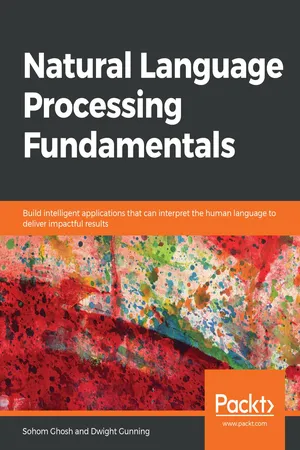
Natural Language Processing Fundamentals
Build intelligent applications that can interpret the human language to deliver impactful results
- 374 pages
- English
- ePUB (mobile friendly)
- Available on iOS & Android
Natural Language Processing Fundamentals
Build intelligent applications that can interpret the human language to deliver impactful results
About this book
Use Python and NLTK (Natural Language Toolkit) to build out your own text classifiers and solve common NLP problems.
Key Features
- Assimilate key NLP concepts and terminologies
- Explore popular NLP tools and techniques
- Gain practical experience using NLP in application code
Book Description
If NLP hasn't been your forte, Natural Language Processing Fundamentals will make sure you set off to a steady start. This comprehensive guide will show you how to effectively use Python libraries and NLP concepts to solve various problems.
You'll be introduced to natural language processing and its applications through examples and exercises. This will be followed by an introduction to the initial stages of solving a problem, which includes problem definition, getting text data, and preparing it for modeling. With exposure to concepts like advanced natural language processing algorithms and visualization techniques, you'll learn how to create applications that can extract information from unstructured data and present it as impactful visuals. Although you will continue to learn NLP-based techniques, the focus will gradually shift to developing useful applications. In these sections, you'll understand how to apply NLP techniques to answer questions as can be used in chatbots.
By the end of this book, you'll be able to accomplish a varied range of assignments ranging from identifying the most suitable type of NLP task for solving a problem to using a tool like spacy or gensim for performing sentiment analysis. The book will easily equip you with the knowledge you need to build applications that interpret human language.
What you will learn
- Obtain, verify, and clean data before transforming it into a correct format for use
- Perform data analysis and machine learning tasks using Python
- Understand the basics of computational linguistics
- Build models for general natural language processing tasks
- Evaluate the performance of a model with the right metrics
- Visualize, quantify, and perform exploratory analysis from any text data
Who this book is for
Natural Language Processing Fundamentals is designed for novice and mid-level data scientists and machine learning developers who want to gather and analyze text data to build an NLP-powered product. It'll help you to have prior experience of coding in Python using data types, writing functions, and importing libraries. Some experience with linguistics and probability is useful but not necessary.
Frequently asked questions
- Essential is ideal for learners and professionals who enjoy exploring a wide range of subjects. Access the Essential Library with 800,000+ trusted titles and best-sellers across business, personal growth, and the humanities. Includes unlimited reading time and Standard Read Aloud voice.
- Complete: Perfect for advanced learners and researchers needing full, unrestricted access. Unlock 1.4M+ books across hundreds of subjects, including academic and specialized titles. The Complete Plan also includes advanced features like Premium Read Aloud and Research Assistant.
Please note we cannot support devices running on iOS 13 and Android 7 or earlier. Learn more about using the app.
Information
Chapter 1
Introduction to Natural Language Processing
Learning Objectives
- Describe what natural language processing (NLP) is all about
- Describe the history of NLP
- Differentiate between NLP and Text Analytics
- Implement various preprocessing tasks
- Describe the various phases of an NLP project
Introduction
History of NLP
Text Analytics and NLP

Figure 1.1: Format of call data

Figure 1.2: Call records in a text file
- How many New Year greetings were sent by SMS on 1st January?
- How many people were contacted whose name is not in the contact list?
- NLU: NLU refers to a process by which an inanimate object with computing power is able to comprehend spoken language.
- NLG: NLG refers to a process by which an inanimate object with computing power is able to manifest its thoughts in a language that humans are able to understand.
Exercise 1: Basic Text Analytics
- Open a Jupyter notebook.
- Insert a new cell. Assign a sentence variable with 'The quick brown fox jumps over the lazy dog'. Insert a new cell and add the following code to implement this:sentence = 'The quick brown fox jumps over the lazy dog'
- Check whether the word 'quick' belongs to that text using the following code:'quick' in sentenceThe preceding code will return the output 'True'.
- Find out the index value of the word 'fox' using the following code:sentence.index('fox')The code will return the output 16.
- To find out the rank of the word 'lazy', use the following code:sentence.split().index('lazy')The code generates the output 7.
- For printing the third word of the given text, use the following code:sentence.split()[2]This will return the output 'brown'.
- To print the third word of the given sentence in reverse order, use the following code:sentence.split()[2][::-1]This will return the output 'nworb'.
- To concatenate the first and last words of the given sentence, use the following cod...
Table of contents
- Preface
- Chapter 1
- Introduction to Natural Language Processing
- Chapter 2
- Basic Feature Extraction Methods
- Chapter 3
- Developing a Text classifier
- Chapter 4
- Collecting Text Data from the Web
- Chapter 5
- Topic Modeling
- Chapter 6
- Text Summarization and Text Generation
- Chapter 7
- Vector Representation
- Chapter 8
- Sentiment Analysis
- Appendix